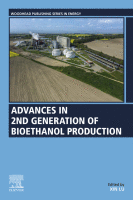Browse content
Table of contents
Actions for selected chapters
- Full text access
- Book chapterAbstract only
Chapter 1 - General introduction to biofuels and bioethanol
Panpan Wang and Xin Lü
Pages 1-7 - Book chapterAbstract only
Chapter 2 - The need for biofuels in the context of energy consumption
Xing Guo and Xin Lü
Pages 9-30 - Book chapterAbstract only
Chapter 3 - More than biofuels: use ethanol as chemical feedstock
Xin Wang and Xin Lü
Pages 31-51 - Book chapterAbstract only
Chapter 4 - Essential process and key barriers for converting plant biomass into biofuels
Fan Zhao, Yanglei Yi and Xin Lü
Pages 53-70 - Book chapterAbstract only
Chapter 5 - Composition of plant biomass and its impact on pretreatment
Chenxian Yang and Xin Lü
Pages 71-85 - Book chapterAbstract only
Chapter 6 - Pretreatment: Toward effectiveness and sustainability
Xin Wang
Pages 87-112 - Book chapterAbstract only
Chapter 7 - Tiny bugs play big role: Microorganisms’ contribution to biofuel production
Yanglei Yi
Pages 113-136 - Book chapterAbstract only
Chapter 8 - Overcome saccharification barrier: Advances in hydrolysis technology
Tao Wang and Xin Lü
Pages 137-159 - Book chapterAbstract only
Chapter 9 - Strategies on simultaneous fermentation of pentose and hexose to bioethanol
Man Zhou and Xin Lü
Pages 161-211 - Book chapterAbstract only
Chapter 10 - Industrial bioethanol production: status and bottlenecks
Zhu Qiao and Xin Lü
Pages 213-227 - Book chapterAbstract only
Chapter 11 - Ending fossil fuels addiction: Prospects for biofuels
Yuanyuan Shan and Xin Lü
Pages 229-242 - Book chapterNo access
Index
Pages 243-254
About the book
Description
Advances in 2nd Generation of Bioethanol Production presents a comprehensive overview of technologies and strategies for the conversion of lignocellulosic biomass. This includes issues like sustainable production, environmental and economic benefits, and the main hurdles for upscaling and achieving commercial viability. The book assesses the current biomass conversion technologies, their readiness level for commercial production, and applications of bioethanol in bioenergy and chemical feedstock. The essential conversion process of 2nd generation biofuels, including feedstock composition and pretreatment, is then broken down, with special focus on advantages and pitfalls of each feedstock and process. It also explores the advances and challenges of bioprocessing, hydrolysis technologies and simultaneous fermentation of pentose and hexose. Finally, it presents the current status and bottlenecks for industrial production of bioethanol, as well as its future prospects.
Its interdisciplinary approach, drawing upon plant biology, chemistry, biochemistry, microbiology, and genetics, makes Advances in 2nd Generation of Bioethanol Production a must-have reference for researchers in academia and industry R&D. It allows them to compare challenges and opportunities of new technologies and identify the gaps where new technology is needed. Practitioners in the industry also benefit from the information on working principles, design and control of the bioethanol production process, highlighting areas where technology innovation and investment should be placed. Graduate students and researchers newly entered in this field find here a key-resource to thoroughly understand the process as well as the fundamentals of bioethanol and bioproducts production from lignocellulosic biomass.
Advances in 2nd Generation of Bioethanol Production presents a comprehensive overview of technologies and strategies for the conversion of lignocellulosic biomass. This includes issues like sustainable production, environmental and economic benefits, and the main hurdles for upscaling and achieving commercial viability. The book assesses the current biomass conversion technologies, their readiness level for commercial production, and applications of bioethanol in bioenergy and chemical feedstock. The essential conversion process of 2nd generation biofuels, including feedstock composition and pretreatment, is then broken down, with special focus on advantages and pitfalls of each feedstock and process. It also explores the advances and challenges of bioprocessing, hydrolysis technologies and simultaneous fermentation of pentose and hexose. Finally, it presents the current status and bottlenecks for industrial production of bioethanol, as well as its future prospects.
Its interdisciplinary approach, drawing upon plant biology, chemistry, biochemistry, microbiology, and genetics, makes Advances in 2nd Generation of Bioethanol Production a must-have reference for researchers in academia and industry R&D. It allows them to compare challenges and opportunities of new technologies and identify the gaps where new technology is needed. Practitioners in the industry also benefit from the information on working principles, design and control of the bioethanol production process, highlighting areas where technology innovation and investment should be placed. Graduate students and researchers newly entered in this field find here a key-resource to thoroughly understand the process as well as the fundamentals of bioethanol and bioproducts production from lignocellulosic biomass.
Key Features
- Presents fundamentals and state-of-the-art of available pathways for bioethanol and bioproducts production from lignocellulosic biomass
- Discusses key-challenges for large scale production of bioethanol, such as pretreatment and hydrolysis
- Covers the specificities of various feedstocks and processes, the role of microorganisms in fermentation, saccharification limitations and challenges in the C5 and C6 fermentation
- Presents fundamentals and state-of-the-art of available pathways for bioethanol and bioproducts production from lignocellulosic biomass
- Discusses key-challenges for large scale production of bioethanol, such as pretreatment and hydrolysis
- Covers the specificities of various feedstocks and processes, the role of microorganisms in fermentation, saccharification limitations and challenges in the C5 and C6 fermentation
Details
ISBN
978-0-12-818862-0
Language
English
Published
2021
Copyright
Copyright © 2021 Elsevier Inc. All rights reserved.
Imprint
Woodhead Publishing
